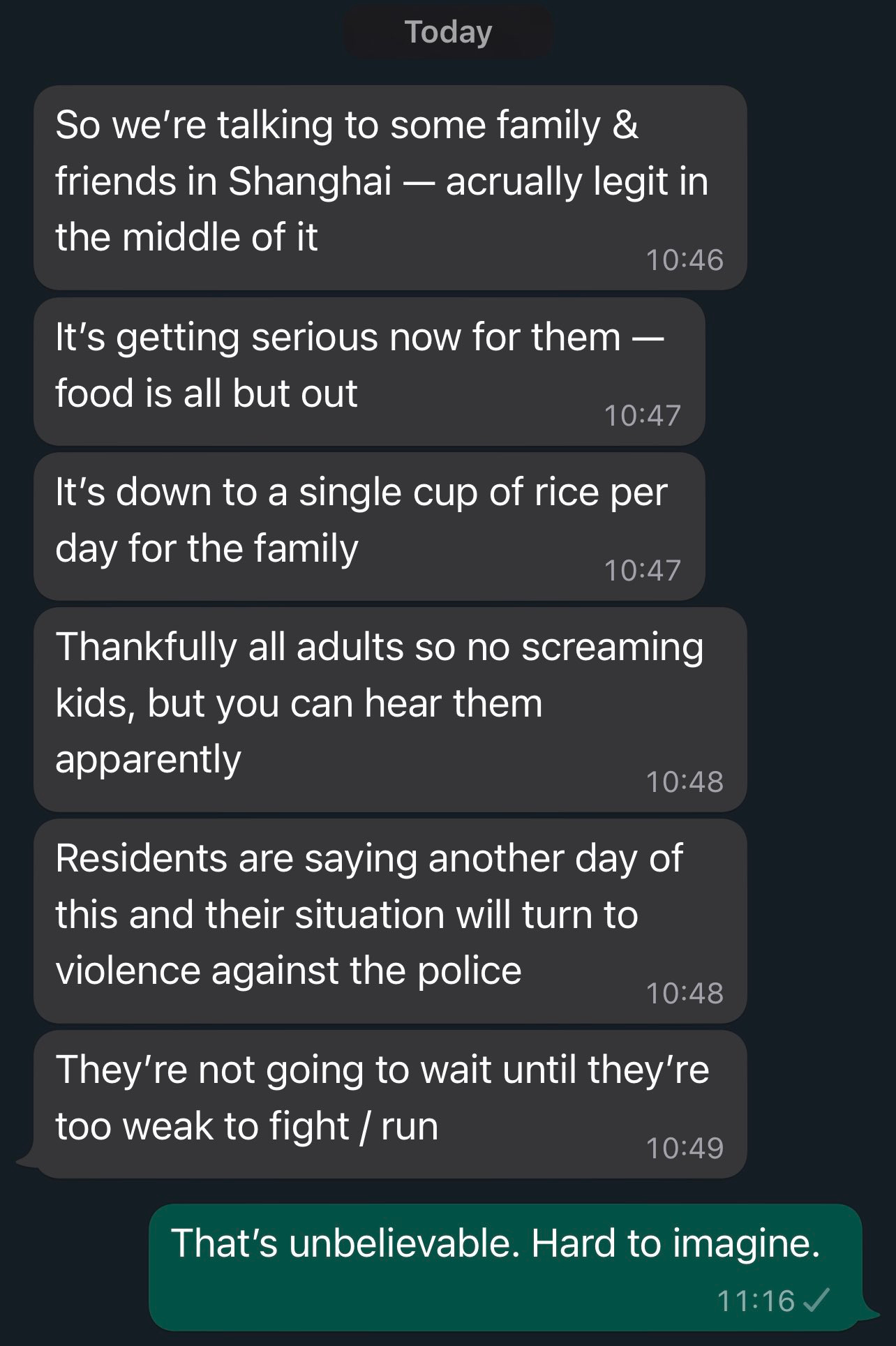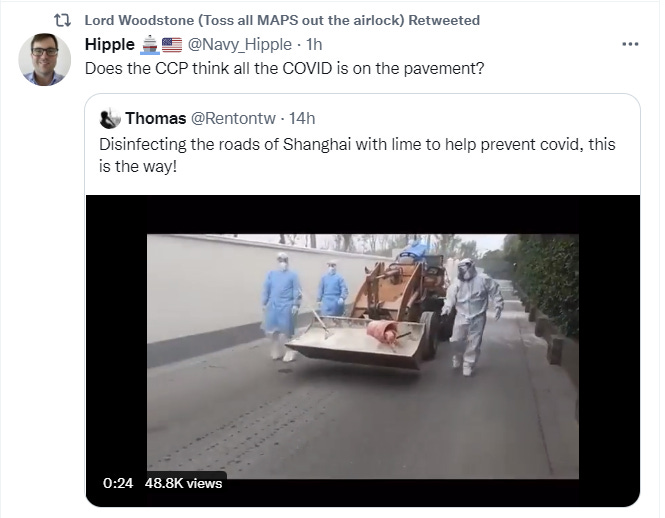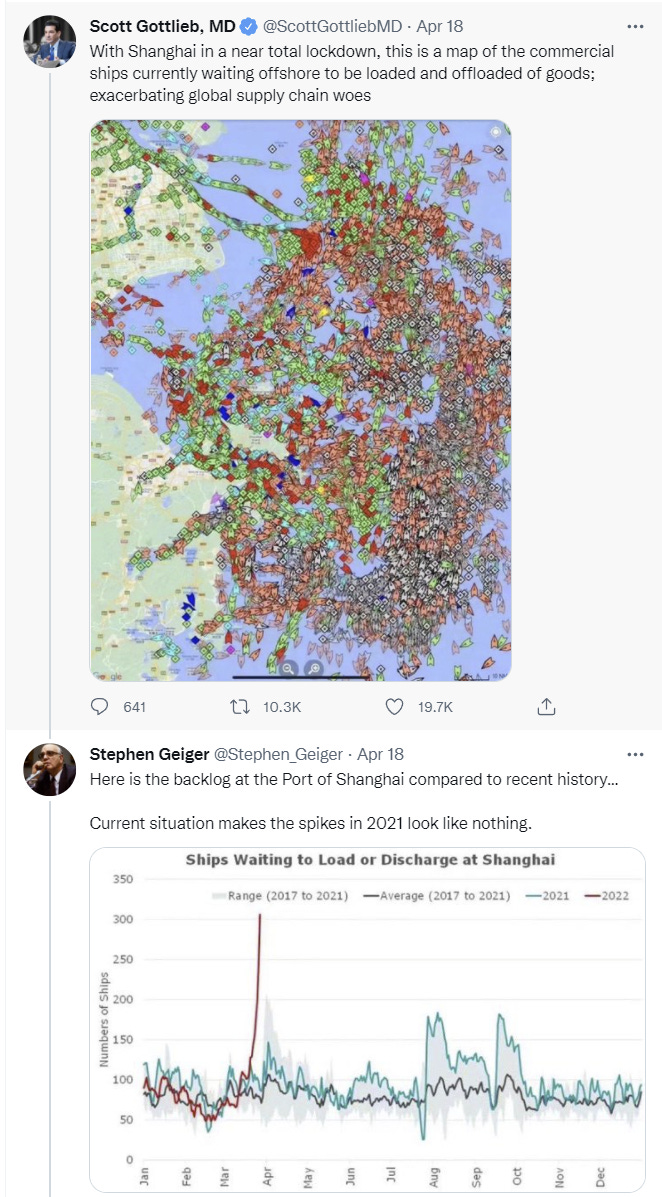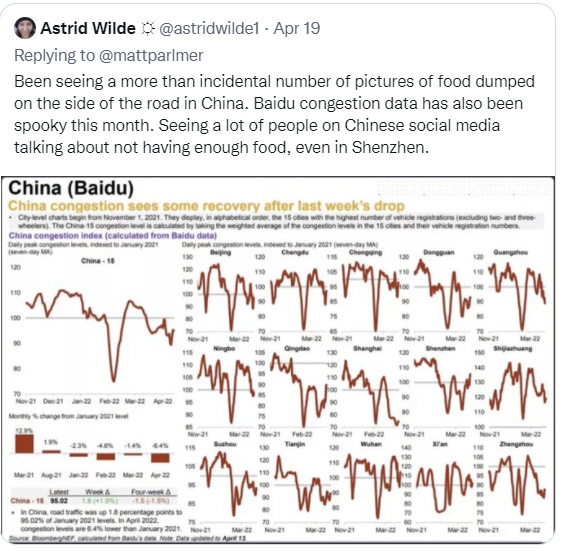What is happening in China?
That is by far the most important Covid-related question right now. The future of Covid elsewhere might be frustrating, but what is happening in China is potentially a much bigger deal, from disrupting supply chains all the way up to potential loss of the Mandate of Heaven.
I want to emphasize that it is very difficult to know what is going on inside China and my sources for this are not the best. I find the Ukraine war a relative epistemic cakewalk compared to this. So please understand that the alarmist claims from various threads are to be taken with large heapings of salt.
Stocks
One measure that is objective but that I have not previously looked at is the Chinese stock market, which looks like this.
By contrast, here’s the US stock market using the same style graph:
Since the start of March, the US stock market is up while the Chinese stock market is down, approximately +5% vs. −14%. Given that this is long term value, that’s a very large difference. China had been underperforming for the previous year as well, which could be any number of things related or unrelated to Covid.
Cases
The other obvious thing to check, despite its reliability issues, is the official case count. Remember that this is on a log scale. It matches up with previous data – those who understand my model here can look at the graph then skip this section.
This continues to look a lot like a steady straight line up, from 0.1 cases per million mid-February, a little over two months ago, to about 20 cases per million now. China’s Zero-Covid countermeasures have slowed the growth in percentage terms, and have done extra slowing of growth in the last two weeks, but growth is still positive.
Taken at face value, this is potentially close to the very worst case scenario for China.
The best case scenario is that one can indeed sustain Zero Covid at a price worth paying. We now know this does not apply to China.
The next best scenario is China realizes they cannot maintain Zero Covid, so they use their prevention efforts where and when they are useful. They protect the most vulnerable, and they use countermeasures to flatten the curve when case rates get super high, taking advantage of cultural differences and state capacity in such matters to do so at lower cost than similar actions would require in the West.
Alas, we live in neither of these scenarios.
Instead, China has sufficient (however horribly painful and unsustainable) countermeasures to almost contain the spread. This prevents Xi from realizing or being forced to admit that Zero Covid has failed, and the policy continues. Local officials impose horribly expensive restrictions to avoid becoming the next Shanghai or the next scapegoat, as the short and long term pain piles up, but no one is in position to change course.
Then, when we get closer to the peak in cases, and the time comes that such prevention efforts would save lives, China will have already used much or even most of its state capacity, economic capacity and public goodwill for lockdowns, and will not have such tools fully available. Slowing down case growth to ‘flatten the curve’ only works when you are within a few doublings of the peak. Any efforts spent before that, except insofar as you bought valuable time, are wasted.
Deaths
This is what China is reporting. Note that this isn’t per-million, this is actual individual deaths reported on a daily basis, full stop.
This is also, of course, a joke rather than a plausible lie. There is zero chance these numbers are remotely accurate, even if case data is mostly accurate. What is interesting is that the dam has broken. On April 20, China stopped pretending that this entire Covid wave was somehow entirely without deaths. I am curious what caused that change.
The real number of deaths is far higher. We will never know what it was, but deaths so far will almost certainly be overwhelmed by deaths in the future so it scarcely matters. How many of those get reported depends on many factors.
Shanghai
Shanghai became the reported epicenter of the Chinese pandemic several weeks ago. The vast majority of reported cases take place in Shanghai. The city has been under strict lockdown with tons of tests, yet cases stubbornly refuse to decline. We know that the countermeasures there, despite the high human cost, are not working, even if we don’t know exactly why they are not working.
What is most odd is that those countermeasures are not only not working in absolute but in relative terms. I expected Shanghai to become a smaller percentage of cases over time because it has countermeasures other places do not, yet that did not happen.
There have been some protests, but if anything news of such events has quieted down since peaking about a week ago. Part of a long thread of happenings, this is a perspective from a Chinese state media source on a BBC report on unrest in Shanghai, from 15 April. Original thread is from a very anti-CCP source. Scrolling up in that thread provides a bunch of ‘things are bad and people don’t like it’ anecdotes, but so far control has been maintained and a lid kept on things.
We saw this claim on 17 April, but I did not then see more such claims. Things did not break down a day or two later.

This is a NY Post report from 18 April, from someone stuck in Shanghai. Essentially it is a total lockdown, with tons of Covid tests, yet everyone complies because they see no alternative.
This time around, what is going on is just utterly unbelievable. Despite high vaccination rates and a weaker variant of the virus at large, the restrictions are way tougher this time.
I’ve been locked in my apartment with my wife and kid for more than a month, and I have had to take more than 20 COVID tests during this time. Government health workers appear in white suits every other day, and neighborhood wardens use megaphones to summon everyone outside to take their tests.
There’s more than 1,000 people living in my complex — and everyone complies. Chinese people in general are pretty obedient. Privately, many Chinese friends tell me they don’t like the procedure and lockdown but believe going along with it is the quickest way back to normality.
…
Things have eased off this week, but last week we had serious problems ordering food online and were surviving on government handouts. The lockdown meant most delivery drivers weren’t working. So there was plenty of food, but we couldn’t get our hands on it.
We weren’t alone: My social media were full of angry, sad and bewildered Chinese friends asking where their next meal would come from. In one of the most modern connected cities in the world used to being able to order anything online and have it turn up on their doorstep soon after, this was nothing short of traumatic.
Seeing open criticism of the government was also quite stunning as it’s something that just never happens. It all added up to a surreal atmosphere.
There’s also fear this time around — not of the virus itself but of testing positive. If you do, you’ll be taken away to a makeshift “hospital” where the lights may be on 24⁄7 and there are no showers. You’ll be isolated from the outside world and not let out until you test negative four or five times.
That matches older reports on the situation in Shanghai. One possibility is that officials are loosening and tightening in response to social unrest and food shortages, to keep things under control, but that having to do so is preventing the lockdown from working. Again, this level of lockdown should be sufficient for the city in question while it continues to see a decline in cases. Failing even on those terms is strange.
These firsthand accounts make it more clear what likely is happening. Shanghai is divided into xiaoqus, complexes with gates that sometimes contain thousands of people. What China did, as I understand it, was lock everyone inside their xiaoqus. Within each one, movement remained free. So lots of people are now locked inside heavily confined spaces, forced to interact with their neighbors who they would usually never interact with the same way I mostly don’t interact with my building here in New York, as that’s the only way they can interact with anyone and more importantly the only practical way to get reasonable supplies of food.
If even one case is found inside the xiaoqu, everyone gets locked down. Which is a penalty for being late problem – you’re already fully screwed if anyone in the group has Covid, so a lot of people likely act as if no one in the xiaoqu has Covid. Which means the total amount of spread ends up not obviously being lower than before/without the lockdown, if there is any method of infections crossing between xiaoqus, which is likely provided by testing and food deliveries.
China at least makes a plausible case that it has a ‘whatever it takes’ style approach to the situation, but that is not combined with careful scientific modeling of the situation. Quite the opposite.

Thus it makes perfect sense that they may have cracked down on many levels that don’t matter while leaving vulnerabilities that mean the situation keeps getting worse anyway. A lot of the pain being inflicted is accomplishing nothing. Consider that no one is spending any time outside.
The Port of Shanghai has a rapidly increasing backlog. The top image is quite the Rorschach test. At least twice I thought I kind of saw a dragon. The second is less subtle.

Shanghai is only one port, but it is an important one. The problem isn’t confined to Shanghai, but it would be a big deal even if it were, although it sounds like for now things have not spiraled too far out of control.
None of that is good, but it mostly (the airport question is scary depending on how much rerouting is possible) sounds survivable on its own at least for a while. It seems increasingly likely May will not be a productive month for Shanghai, causing increasing ripple effects.
Residents of some areas of the city are now being asked to relocate to a quarantine facility outside of the city. This seems like an escalation that could potentially make the situation a lot more volatile. By all accounts things are tightening further, which is indeed what one has to do if progress is not being made. I have little faith that they will choose the right tightening to do.
When I last posted on the situation in Shanghai I was criticized for using the term ‘starvation’ when no one was outright dying for lack of food. I don’t think we know whether that is happening – it sounds like if someone does not understand how to navigate the system, there could be severe issues getting enough food to eat, things have gone on long enough now that full starvation is potentially in play, and I do not think the safety valves to prevent this from happening seem all that reliable. Still, if it was widespread, we would know about it.
So I want to clarify that in terms of what has happened so far ‘starvation’ refers mostly to people getting inadequate calories and not to danger of imminent death. The thing is, that could change. Already in Woodstone’s thread below there is a specific claim of someone starving to death. There is nothing inherent in the dynamics involved that would confidently prevent the worst from happening. Certainly there is precedent.
China Overall
The bigger food security question is longer term, and combines with worldwide concerns about lack of access to fertilizer potentially depressing crop yields. If farmers are unable to plant their crops in many parts of China, or have to plant at non-ideal times or under sub-optimal conditions, and the outside market is already dangerously tight, that could be a very, very bad combination.
We have reports of farmers being barred by Covid restrictions from plowing their fields, but it is hard to know how widespread is this issue. The central government was reportedly trying to stop this from happening, but the local incentives push in such directions.
Cases not going up faster outside Shanghai, while Shanghai tries so hard yet fails to contain the outbreak, indicates some dramatic actions must be going on throughout much of China.
Here’s Jon Stokes giving a grim perspective on potential for food shortages and supply chain issues (there’s some talk about Ukraine there too, which I didn’t copy over). He tends to offer grim perspectives and to pay a lot of attention to potential very bad outcomes, so adjust for that, and he makes it clear (very much to his credit) his uncertainty over how bad things are, but I am confident he’s being concerned for reasons.
Outside of China, this thread about various food processing plants blowing up is wild. Again, I don’t know what to make of it, could still be law of large numbers. And a few years ago, I would have thought very little about such concerns.
Yet now I realize that I strongly agree with Jon that, while there may or may not be a huge problem coming our way and things (at least in America) will probably be fine, if there was a huge problem we cannot assume the Responsible Authorities would notice. Nor should we assume the market would come anything close to fully noticing either. There are no Responsible Authorities and adults out there, it’s only us.
Here’s the most extreme ‘China is screwed’ perspective I have seen so far. I asked on Twitter whether anyone could speak to its accuracy, and didn’t get much of anything either way. Lord Woodstone did link to a post documenting the sources.
My take is that the claims below are cherry-picked and framed to be seen as maximally alarming, but that even so there is a lot to be alarmed about.
A key point for such problems is that the Chinese mostly consume fresh food, which is good for their health but makes them more vulnerable to supply chain disruptions. It is a lot easier for the food to go to waste.

There is also a link to a follow-up post on water. The sources documenting the thread above are listed here.
I’m interested in the “Xi will be assassinated/otherwise killed if he doesn’t secure this bid for presidency” perspective. Even if he was put in a position where he’d lose the bid for a third term, is it likely that he’d be killed for stepping down? The four previous paramount leaders weren’t. Is the argument that he’s amassed too much power/done too much evil/burned too many bridges in getting his level of power?
Although I think most people who amass Xi’s level of power are best modelled as desiring power (or at least as executing patterns which have in the past maximized power) for its own sake, so I guess the question of threat to his life is somewhat moot with regards to policy.
Too much power, I would assume. Yet he didn’t kill Bo Xilai.
So, uh, how should we start preparing for the impact of this here in the West? Stock up on food? But electronics we might need early on? Shift our investments away from companies who depend crucially on China in some way?
As an individual concerned about food shortages, you always have the option of tailoring how you buy groceries. A trick I learned from Reddit for stocking up on long-shelf-life foods: watch what food packaging leaves your house in the trash or recycling. Check the best-before date on the package each time you eat something that stores for a relatively long time, especially canned foods and dry goods. This way you can find the approximate rate at which you go through a given item—maybe you usually use 1 box of pasta and 1 can of soup each week for an easy casserole. Then for each item, you get a feel for how much longer you could’ve kept it before its best-by date: I’ve noticed that the pasta I buy often has a date 2-3 years in the future, and canned goods often claim 1-2 years. So if pasta is good for 2 years and I eat 1 box a week, that means I could keep 104 boxes of it if I had the space, and still use up all of it before its best-by. If I eat 1 can of a given soup per week, and it’s best by 1 year in the future, I could keep 52 cans if I had the space.
Now, most foods are safe and nutritious after their best-by or sell-by dates, sometimes long after. But the date is a good lazy rule of thumb for “the manufacturer is confident the packaging will protect it for this long” when you’re getting started. Once you figure out how much stuff you can keep around and still use it in time, figure out how much space you’re willing to commit to your personal food security insurance. To figure out which long-shelf-life items are best for you to store in your limited space, consider how they come together into meals (would this item be useless to you without a specific fresh ingredient?) and whether eating from the selection you choose to store would offer balanced nutrition.
Once you’ve calculated what you want to store based on these constraints, buy a little extra of your storage items each time you grocery shop, until you’ve reached your target quantities. Then all you have to do is remember to rotate through them: eat the oldest of each item first. If you learn that the enjoyment you get from a particular item declines when it reaches a certain age that’s younger than the manufacturer’s stated use-by, treat that as its new de facto use-by date going forward. If your dietary needs change, like if you discover a new allergy or decide you don’t like a given item any more, you can easily donate your extras to a local food pantry because everything you store will still be in date.
The trick to this process is to make it as easy as possible. If there’s a part of the food storage process that makes you look for an excuse to stop, change it so you don’t hate the process. Having food on hand is important preparedness for natural disasters as well as man-made ones, and being able to drop your grocery bills to 0 for a few weeks or months while still eating well is a wonderful trick to keep up your sleeve in the world of personal finance.
If there are new electronics that you want primarily because they’re new, like the latest phone, stocking up early won’t buy you much benefit. But if there are secondhand or older electronics that you’re certain you’ll want in the foreseeable future, increased competition for them in the future may suggest that prices will be better now than later.
Push officials to redirect corn subsidies for ethanol toward food? Keeping American corn production alive in case it suddenly was required was one of the reasons for said subsidies[1], after all.
(Of course, this doesn’t help the upstream portions of the food supply chain.)
...to the best of my knowledge, although I note that I can’t find anything explicitly mentioning this at a quick look.
I talked to a good friend of mine who is a (I originally had a pretty large descriptor of bonafides here but decided to minimize her exposure surface area). I generally consider her to be very knowledgeable/a very Chinese govt insider point of view, but generally with a Chinese positive slant.
Her claim was that the tepid Shanghai covid response was due to conflicting local vs. national govt priorities. in that the Shanghai govt wanted to coexist with covid due to having high # ICU beds/population and having relatively high vaccination rates. Shanghai only started with stronger measures closer to covid 0 policies after the natl govt exerted pressure.
Re: food, her claim is that China has a national food stockpile to feed the country for 2-3 years, and that while there are short term supply chain issues she isn’t worried about mass starvation happening on any short term time scale. She seems to think that worldwide there is reasonable probability of significant food issues but seems very unconcerned about the local food situation. I was somewhat skeptical of the 2-3 years food stockpile claim but my very quick googling makes it seem like china does have a huge food stockpile
David Friedberg said they had 1.5 years on the “All In Podcast”. He was saying they may use that food stockpile as leverage over other countries who need food due to the Russia/Ukraine war disrupting wheat production.
Regarding the death reporting change South Morning China Post had a story the other day about how only one death in Shanghai had been reported for the entire lock-down and noting how unrealistic that was. Seems the the local government units were being VERY cautious with causing an concerns—by locals who are already pissed and by the higher authorities in Beijing. I cannot find the story again just no so no link to off but it was after this ran that it seems more deaths started being reported.
Most seems to be related to classification and the local government units applying a much stricter criteria than the national level agencies had actually defined.
I wonder if we’re starting to see some cracks in the image of China as a good illustration of state competency. Related to the above “They protect the most vulnerable”
(https://www.npr.org/2022/04/19/1093620434/45-cities-in-china-are-in-some-sort-of-covid-lockdown-heres-the-toll-thats-takin)
This view, putting the vulnerable at more risk, is also report in several stories published in SCMP as well as its one on the unusual death statistics being report.